Contents
- A General Overview of Goldendoodle
- Goldendoodle Appearance
- Goldendoodle Energy or Activity Level
- Cross Breeding a Perfect Goldendoodle
- Goldendoodle Generations
- Reasons for the Different Goldendoodle Generations
- What are the Labeling standards for Goldendoodle Generations?
- Letter ‘F’
- The Number
- Letter ‘B’
- The Different Goldendoodle Generations
- The 1st Generations – F1
- The 1st Generation Backcross – F1b
- The 2nd Generation – F2
- The 2nd Generation Backcross – F2b
- Multi-generational and F3
- So What Goldendoodle Generation is the Best?
- Goldendoodle Personality and Temperament
- Goldendoodle Common Health Issues
- Grooming Goldendoodle
- Pros and Cons of Getting a Goldendoodle
- Where to Buy A Goldendoodle
- Is A Goldendoodle Right For You?
- Other Golden Retriever Mixes
Ever wondered what would happen if you breed a purebred Poodle with a purebred Golden Retriever? Well, the result is a Goldendoodle. This beautiful crossbreed is usually a very friendly, intelligent, and quite energetic companion that perfectly fits into your family and home.
This article is all about Goldendoodles. Here we’ll get you all the information you need about this beautiful design breed. So do read on, I guarantee you’ll enjoy it
A General Overview of Goldendoodle
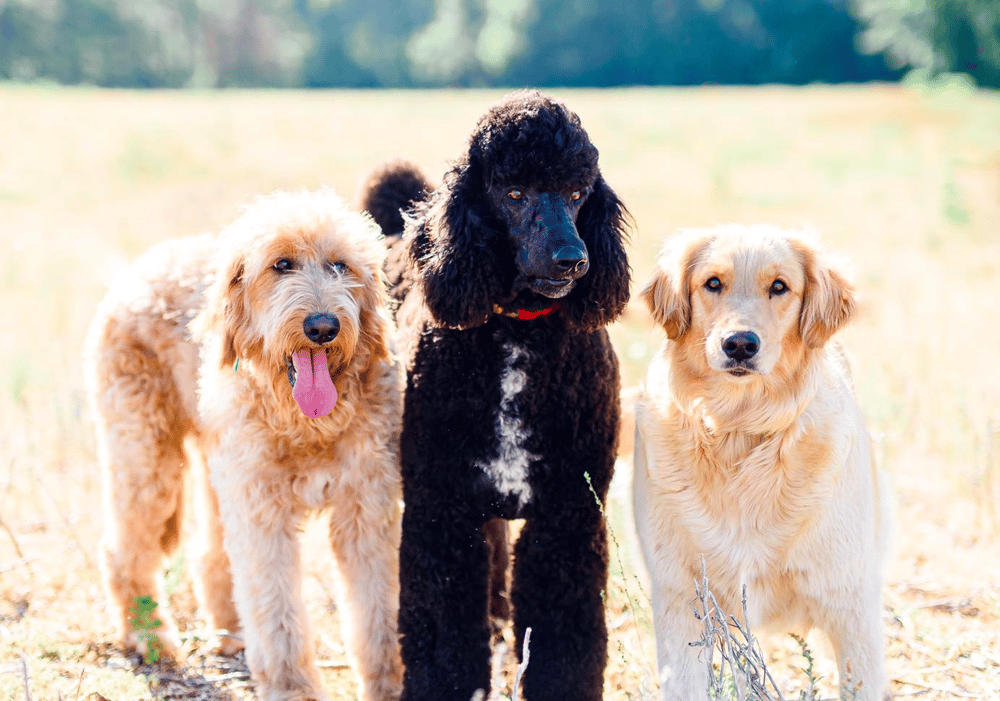
Back in the 60s, the Cockapoo and Labradoodle became popular as guide dogs for the visually impaired. A larger breed was needed and called upon by most service dog trainers.
Breeders in return responded to the call by combining the intellect and low shedding tendency of the poodle with the sunny tendencies of the golden retriever.
The dogs they produced were generally intelligent, friendly, more allergy-friendly, and larger than their two predecessors.
The Goldendoodle, which was first bred in the year 1989, became popular in the 1990s with a very high demand for the designer breed coming from social media.
So far, no breed club has been formed to encourage the development and growth of the Goldendoodle breed.
However, they are recognized members of the American Canine Hybrid Club and can also be registered there.
Basic info on the Goldendoodle or Groodle:
| Height | 13 – 24 inches |
| Weight | 15 – 90 pounds |
| Lifespan | 9 – 14 years |
| Colors | |
| Suitable for | First-time dog owners, couples, family |
| Temperament | Loyal, affectionate, intelligent, playful, affectionate, playful |
Goldendoodle Appearance
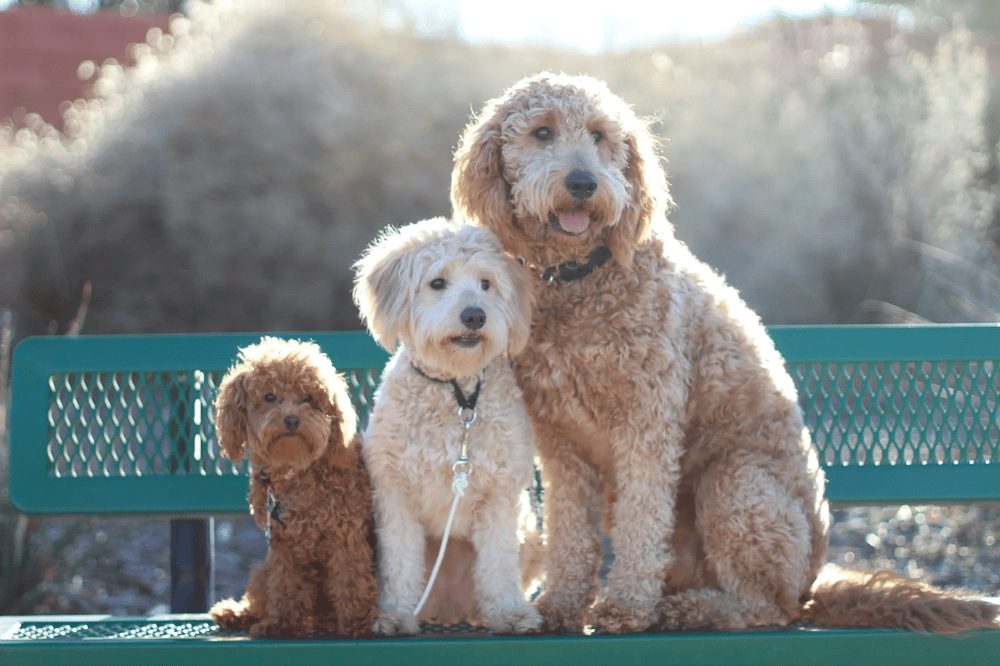
The Groodle or Goldendoodle was first bred to be large, but with such high demand for the hybrid, breeders received requests for smaller, many versatile versions of the Groodle.
Poodles of different sizes were bred with Golden retrievers to produce more diverse options of the breed without diluting or corrupting the desired personalities and characteristics of the Dogs.
There are three sizes of Goldendoodles currently available:
| Size | Height | Weight |
| Miniature Goldendoodle | 13-15 inches | 15-35 lbs |
| Small Goldendoodle | 17- 20 inches | 40-50 lbs |
| Large Goldendoodle | 20-24 inches | 50-90 lbs |
Since they are hybrids, their characteristics and traits are not set. Therefore, there is no guarantee that your purchased Goldendoodle puppy will fit within your desired weight or size range.
Goldendoodle Energy or Activity Level
Goldendoodles or Groodles generally have moderate energy levels with smaller Goldendoodles having fewer energy levels than their larger kin.
They require playtime or regular good walks and generally regular exercises every day.
And if you are interested in dog sports like flyball, agility, rally, and obedience events, they possess the athletic traits, enough to participate (assuming the dog’s health is good enough). They can also serve as perfect therapy dogs.
Both Parents of the standard Goldendoodle tend to be quick and smart learners. Start socializing and training early and use positive reinforcement methods such as play, food, and praise as rewards to make a great and lovable companion.
Also, Goldendoodles are perceived to be hypoallergenic dogs. This means they can be surrounded by people with dog allergies.
This is mainly because the poodle (one of the parent breeds), is also perceived to be hypoallergenic.
However, this is all speculative, as allergies are not caused by the dog’s fur coat. But caused by dander which is the dead skin cells shed by all dogs and even people.
Note: No scientific evidence currently exists saying that a breed or hybrid is more allergenic or less allergenic than any other breed.
People with allergies can react differently to different dogs, so no reputable breeder can give a guarantee that their dog is hypoallergenic.
Cross Breeding a Perfect Goldendoodle
Just to achieve a certain temperament, working ability, and appearance, humans have been cross-breeding dog types for millennia.
This is mainly how most purebreds like the Australian Shephard, the Affenpinscher, the Brussels griffon, the Leonberger, the Doberman pinscher, the German wirehaired pointer, and the Black Russian Terrier, became popular.
But simply cross-breeding two breeds constantly is not enough. To be able to achieve consistency in size, temperament, and appearance, breeders need to carefully select puppies with the desired characteristics and breed them for several generations to establish their traits.
The demand for hybrids like the Goldendoodle became high in the last 10-20 years. This is because people generally want dogs that are different from the dogs they are used to.
Goldendoodle Generations
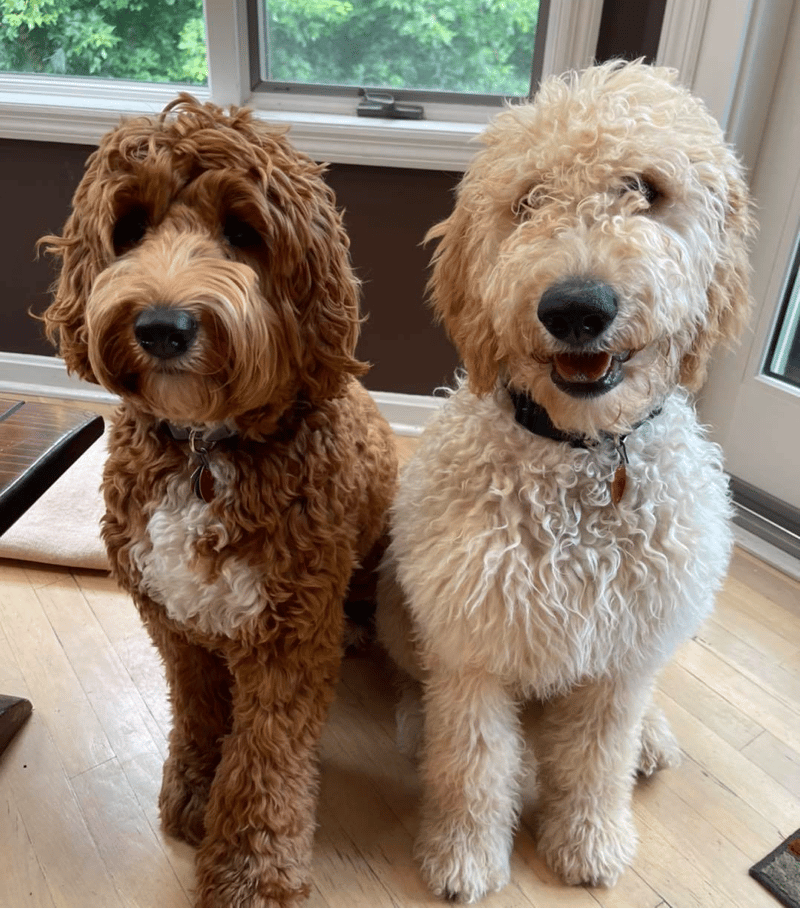
Although responsible breeding can reduce the risk of potential problems, their pedigree or Goldendoodle generation plays an important role in their physical traits and risk of potential health problems.
Reasons for the Different Goldendoodle Generations
Sadly, genetics aren’t as easy to predict as most breeders would like them to be. The first-generation Doodle (F1) is a 50% Golden retriever and a 50% poodle, but it can be very different and inherits different characteristics from both parent breeds.
The first-generation Groodle always inherits the shedding gene from the golden retriever and sheds everything from a small number to an almost complete retriever.
Because F1s always almost shed, I recommend getting a genetically coat-tested doodle from multiple generations. But that’s if getting a hypoallergenic (myth) doodle is your priority.
What are the Labeling standards for Goldendoodle Generations?
For a better understanding, it’s good practice to understand the terminologies used when naming the Goldendoodle generation. It can be confusing at first, but it gets easier once you get used to it.
Letter ‘F’
When labeling Goldendoodle Generations, the letter F is always used at the beginning. The letter F means “Filial Hybrid”. It tells you that it’s a hybrid of two purebred dogs.
The Number
Numbers are the main indicator of the generation to which Goldendoodle belongs. For instance, number 1 indicates the 1st generation while 2 indicates the 2nd generation.
Letter ‘B’
Usually, the letter B by the label end represents a particular generation. This letter means backcross. It indicates that the Goldendoodle generation needs to be returned to the purebred poodle.
Some are returned to the purebred Golden Retriever, but this really isn’t common. You may see the double letter “BB” in some instances, which means that it has been backcrossed twice with the poodle.
The Different Goldendoodle Generations
You might want to read this post first: Goldendoodle Coat Types: Straight, Curly or Wavy [With Pictures]
The 1st Generations – F1
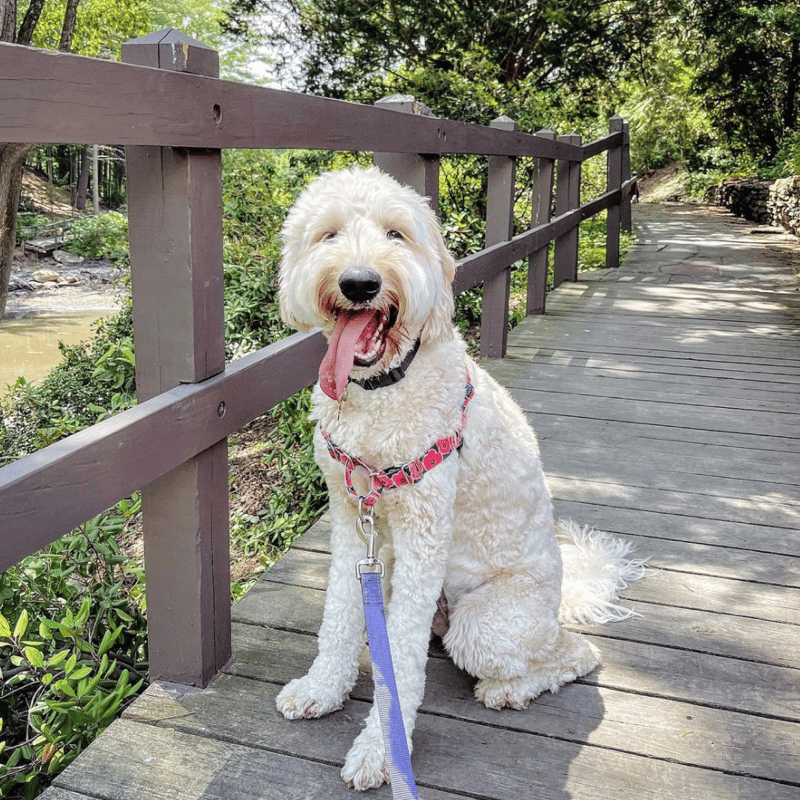
An F1 as we’ve stated before is the direct result of breeding a poodle and Golden Retriever. Because they are first-generation, they inherit some of the traits that come with a phenomenon called “Hybrid Vigor”.
Scientists call it “Heterosis”, and it refers to the enhanced function of biological function caused by genetic diversities. Gene mixing tends to reduce the health risks that might be associated with the purebred specimen
- The Shedding: The majority range from Light to Heavy shedding
- Potential for Allergy: For a family with Severe to moderate allergies, I do not recommend getting this Generation. However, it is okay for a family with mild allergies.
- The Coat: Their coat can be naturally grown from 3-5 inches, and they would require regular grooming and combing. You can choose to trim the fur coat every couple of months. This could help reduce maintenance costs for your Groodle.
- The Grooming: Moderate-High grooming is required.
The 1st Generation Backcross – F1b
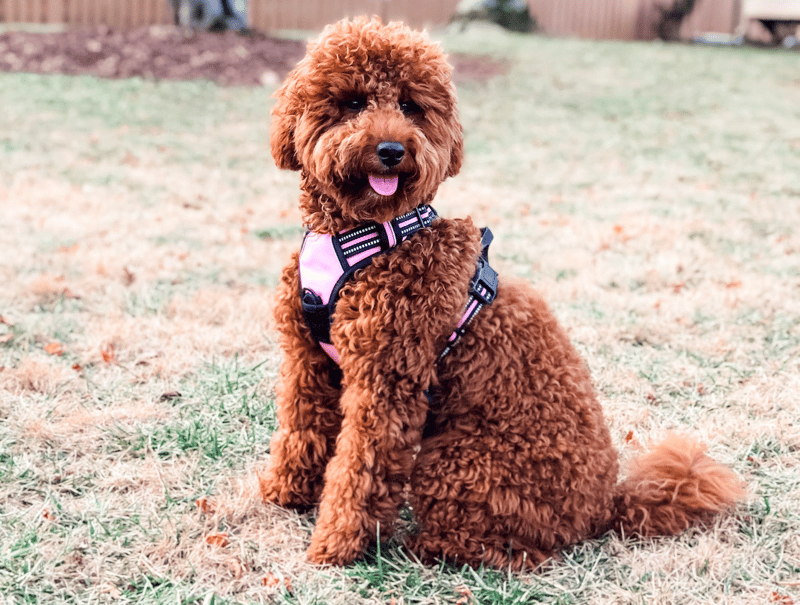
When you backcross, you breed a hybrid back to one of its parent breeds. For an F1 Goldendoodle, the b would mean that it was bred back to a parent purebred. It could either be a purebred retriever or a purebred poodle.
Genetically, It means they are still the first generation. However, the characteristics of either the poodle or the retriever are enhanced.
Some breeders often cross a Groodle and Poodle to increase the possibility of having lower-shedding litters.
Heterosis still remains present, but genetic health testing is becoming increasingly important to rule out carriers of the disease, as multi-generational litters are more likely to inherit the disease from the same line
- The Shedding: 50% of F1b pups don’t shed (inheriting the non-shedding poodle characteristics from both the parents), but 50% of F1b pups must inherit the shedding characteristics of the F1 parent. That means the level of shedding reflects the level of a First generation (low – high shedding).
- Potential for Allergy: There is a 50% chance of becoming hypoallergenic. There is a 50% chance of becoming low – high shedders. (When a breeder coat tests the pups, this factor may be apparent in the first few weeks of life.)
- The Coat: This generation’s coat appearance depends on the characteristics that are inherited from the F1 parents.
It can be anywhere over 35 inches and could become curly, straight, or wavy. If you are worried about how often you brush their fur, you can choose to trim the fur to save grooming time and make your dog comfortable, especially during winter.
- The Grooming: Requires average – high maintenance.
READ MORE: F1B Goldendoodle: Fluffy, Fun, and Companionable Dog
The 2nd Generation – F2
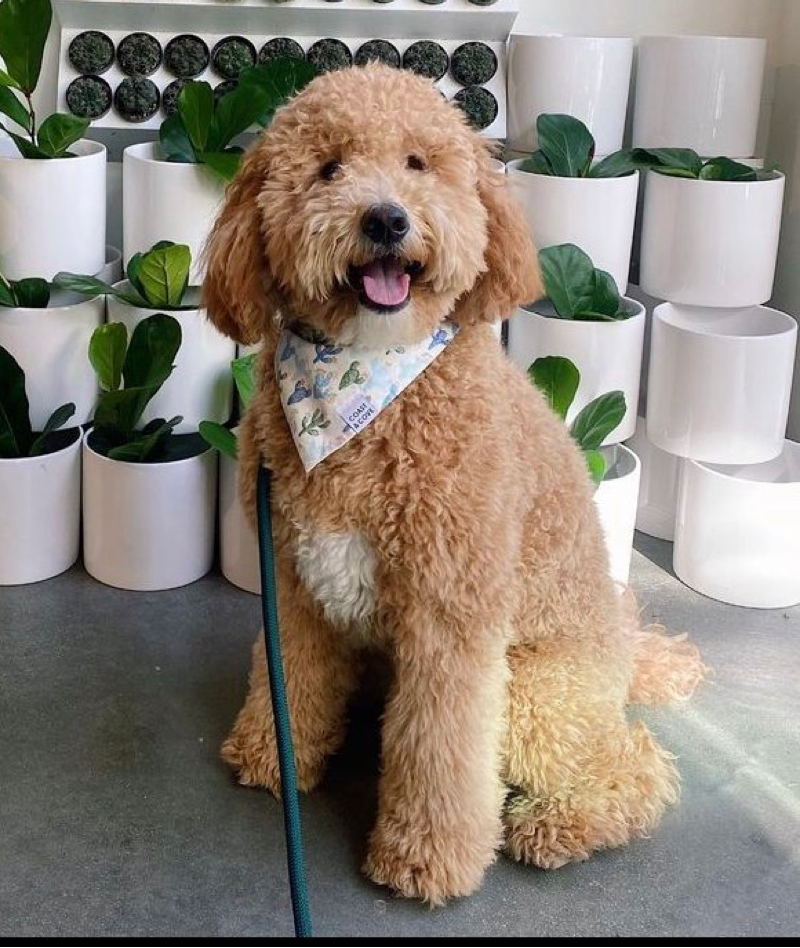
When you breed two F1 Goldendoodles, you get an F2. Most reputable breeders generally don’t advise this combination as it has a 75% chance of shedding the pup.
Since both its parent carries both Retriever and Poodle genes, there’s a 25% possibility that the shedding gene would unite in the pup, making them shed just as much as the purebred retriever (even more than either parent).
Because of how genetics work, you might end up with either full golden retrievers or full poodles after cross-breeding two Groodles.
- The Shedding: Like purebred retrievers, 25% should shed, 50% rarely shed, and 25% do not shed completely.
- Potential for Allergy: Except the genetic makeup for the particular pup is known, and coat testing has been properly done, I don’t recommend these pups to families with high allergies.
- The Coat: The coat can be wavy, curly, or straight. Although it is worth noting that the coat texture of young pups is not enough to indicate the future shedding level as the shedding gene is distinct from the curl gene.
- The Grooming: This depends significantly on the inherited genetic mix of each pup.
The 2nd Generation Backcross – F2b
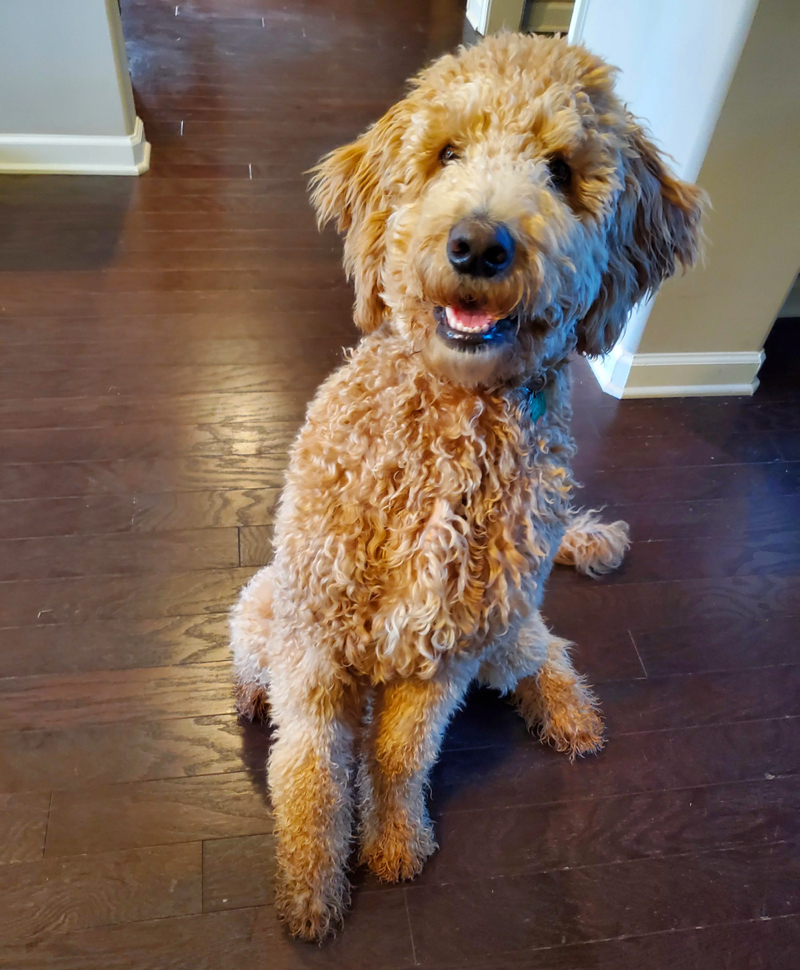
You get an F2b when you cross an F1 Groodle with an F1B. Being a first-generation Groodle, the F1 parent has a combination of predictable coat characteristics (both the non-shedding and the shedding genes). However, the first-generation backcross remains a mystery.
If the F1b parent is not genetically tested, the litter may be an F1b litter or an F2 litter similar to the F2 litter (above).
Genetic health screening is also increasingly important when mixing two parents of the same ancestry.
- Shedding: The F2b pup can lie anywhere from non-shedding (25%-50%), low – high shedding (50% chance), or shed just as high as a full retriever (0%-25%). it all depends on the coat gene carried by the parent F1b.
- Potential for Allergy: Working with breeders to coat test pups and parents is the safest way for families with allergies to adopt F2b pups. Otherwise, the possibility of taking a hypoallergenic pet home does not favor you.
- The Coat: The coat might be wavy, curly, or straight.
- The Grooming: Requires average to high maintenance.
READ MORE: F2B Goldendoodle: What You Probably Didn’t Know
Multi-generational and F3

You can get an F3 by breeding an F2b and F1b, two F2bs, an F1b, and F1B or 2wo f2s. At this stage, most breeders usually refer to them as Multi-generational.
During this stage, the characteristics from both lines can be emphasized negatively or positively, during which careful breeding and genetic testing can screen out unwanted characteristics such as shedding for 100% complete litter of non-shedding pups.
- Shedding: When a breeder performs a coating test, two-parent breeds with zero chance of shedding can be intentionally bred to get a complete litter of non-shedding pups. Even if the breeder is unaware of the genetic makeup of the parents, little guesswork is needed and all shedding-level pups can be produced.
- Potential for Allergy: Working with breeders that are no strangers to genetic coat testing might be the safest way for families with allergies to get multi-generational pups.
- The Coat: Their coats might be curly, straight, or wavy. However, producing non-shedding pups with a straight coat is rare, still, it’s possible. Oftentimes, Multi-generational coats are curly or wavy.
- The Grooming: Requires average to high grooming.
So What Goldendoodle Generation is the Best?

Goldendoodles are generally happy and active dogs, and what’s most important is if you suffer from allergies.
When looking for non-shedding and hypoallergenic Groodles, the best generation are F2b, F1b, and F2bb.
If you’re not really bothered by allergies and shedding, then you can go for the F1 or rather just pick the generation whose coat you might want for your Groodle.
Goldendoodle Personality and Temperament
The Temperament and personality of a Goldendoodle depend on a few factors. Factors like the
Parent’s temperament (Most especially the mom), the inherited gene, and most especially the amount of socialization it receives as a puppy.
Goldendoodles are generally friendly dogs to everyone around them, especially their family. An average well-bred Goldendoodle isn’t aggressive or shy to other people or animals.
When around kids or infants, they are naturally careful and make great playmates for older kids. Goldendoodles are naturally sociable dogs with a natural ability to interact with people. When it comes to trainability, Goldendoodles are smart, and capable of learning when thought with positive reinforcement techniques.
It helps to start training your Groodle puppy the very first day you bring them home. This is because, at a very young age, they are able to learn much faster.
Consider taking your Groodle to a training class from 10-12 weeks. This enables them to learn and socialize. However, you should note that most training classes for puppies require that certain vaccines are up to date.
Goldendoodle Common Health Issues
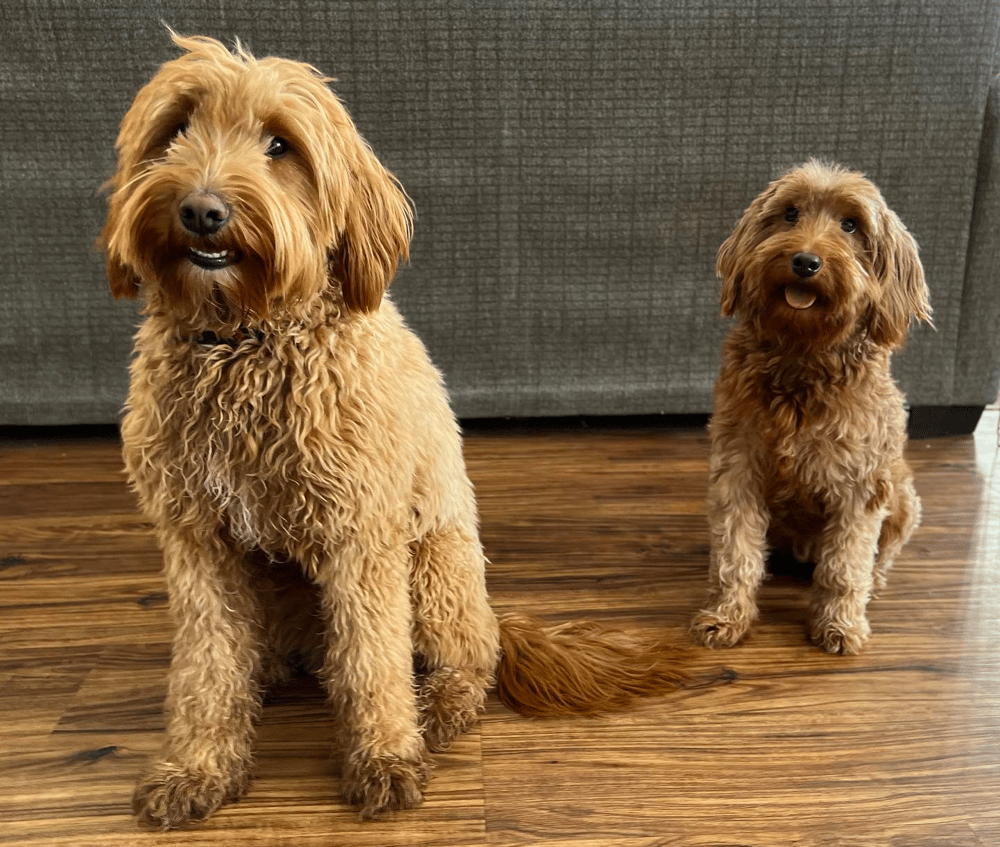
Truth is, all dogs, regardless of the type or breed have the tendency of getting genetic health issues just like we humans have the tendency of inheriting a particular genetic disease.
Stay away from breeders that don’t offer health guarantees for their puppies or who tell you that they isolate their pups from the household for health reasons or tell you that their hybrids are 100 percent healthy and free from all forms of health problems.
This is often misleading as a truly reputable breeder would be honest and open about the problems that may occur in the hybrid line.
Although a golden retriever may be prone to all the health problems of Golden Retrievers, standard or Miniature Poodles, There is a possibility of lowering the chances of such genetic diseases developing. This is because of the diversity introduced by Crossbreeding.
You can’t detect all inherited conditions from a growing Groodle puppy, and neither can you predict that the pup would be free from such conditions in the future.
This is why selecting the right breeder is important. Who is the right breeder? one that prioritizes breeding the healthiest dog possible.
To do this, they have to present documents certifying that the parents and possibly, grandparents of the dog have been thoroughly tested and deemed healthy of any genetic disease or problem.
Also, have it in mind to protect the Goldendoodle pup from the most common health issues facing dogs. Obesity.
Constantly exercising your Goldendoodle and keeping them at their appropriate weight class is the best way to extend the life of your new companion. Making the right health choices as a dog owner is key to ensuring your dog lives long.
Grooming Goldendoodle
Goldendoodles come in a variety of coats. Some resemble a loosely curled poodle, some look like a hairy retriever and some fall off along the middle.
When it comes to grooming, they are not low-maintenance dogs. Brush the Goldendoodle with a slicker brush at least once every other day and plan to clip its coat every 8-12 weeks.
Also, ear infections could be a problem for Goldendoodles. So, make sure you keep their ears clean and water-free, most especially after your dog has gone swimming or bathed.
Report foul odor, redness, head shaking, or any other possible ear problems to your certified vet.
What’s left is routine care. Brush their teeth regularly (or daily) with a veterinarian-approved paste, and try to regularly trim their nails (once a week).
For smaller dogs (which are susceptible to periodontal disease), the benefits of brushing their teeth regularly are that it gives them fresh breath and generally improves their overall health.
Pros and Cons of Getting a Goldendoodle
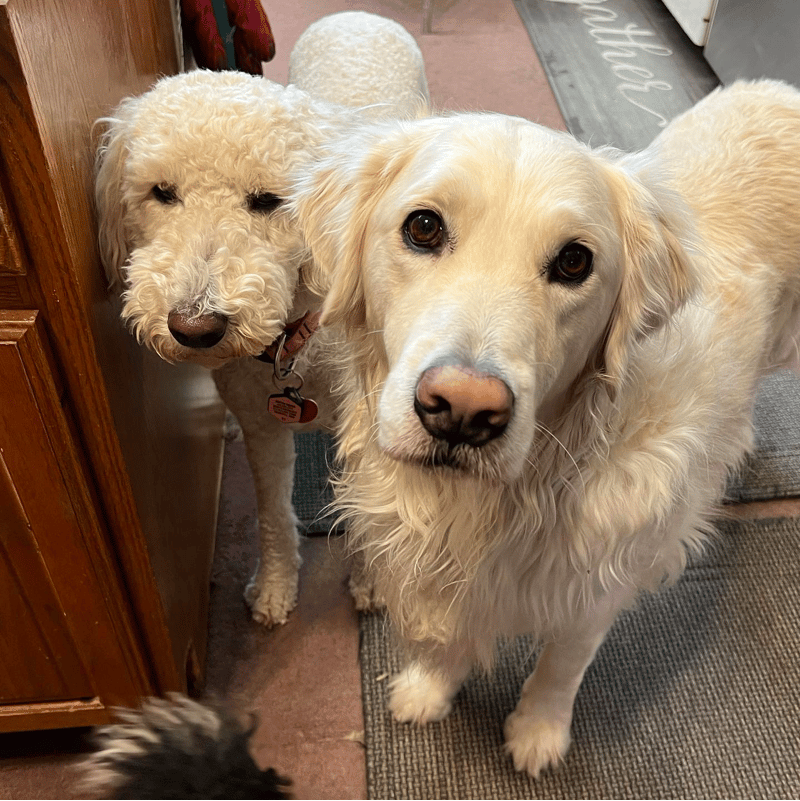
Pros
1. They are Great Companions
Due to their friendly nature and outgoing personality, the Goldendoodle makes for an excellent partner and excellent family pet.
They love to play, run, and generally enjoy people’s company. They also love eating, so expect to receive some adorable begging eyes from your pup at mealtimes.
2. They are Intelligent
It should be of no surprise that this hybrid is one of the smartest crossbreeds, after all Its Golden retriever and poodle parents are equally smart.
An average Groodle pup should learn new tricks or skills (as a service dog) faster and quicker. But do ensure you train and socialize your pup, so it learns to use its high intelligence for good.
3. Little shedding
For those who are allergic to dogs, this might be pretty good information. The Goldendoodle has a fur coat that sheds the least, this is obtained by testing the dog for ‘furnishing’ (a genetic test to determine if a dog coat sheds often).
Cons
1. Requires so much exercise
Both the Golden Retriever and Poodle are very energetic dogs, so it’s no surprise that the Goldendoodle requires a little more than just the basic leash walk around the park.
Set aside at least 30 minutes of your day to exercise your Goldendoodle. Plan a proper exercise regime for your dog (Both physical and mental exercises). This would help your Groodle shake off the excess energy it has.
2. Could be expensive, due to its growing popularity
The price for a Goldendoodle pup ranges from $1500 – $5000. And this is mostly true if you purchase from a reputable breeder (One with all the right health certifications and clearances)
Goldendoodle is a very adorable and cute pet, so it makes sense that a lot of people want one. Once more, do ensure you are getting your pup from a reputable breeder.
3. Would need a lot of grooming
The Goldendoodle has a beautiful coat with lots of fur, keeping the fur healthy and well-groomed is a great way to avoid matting. So I recommend taking your Groodle to a groomer every 6 weeks.
Not properly taking care of your Goldendoodle can lead to painful lesions on the skin of your Groodle. On average, it cost over $100 for a grooming session.
Where to Buy A Goldendoodle
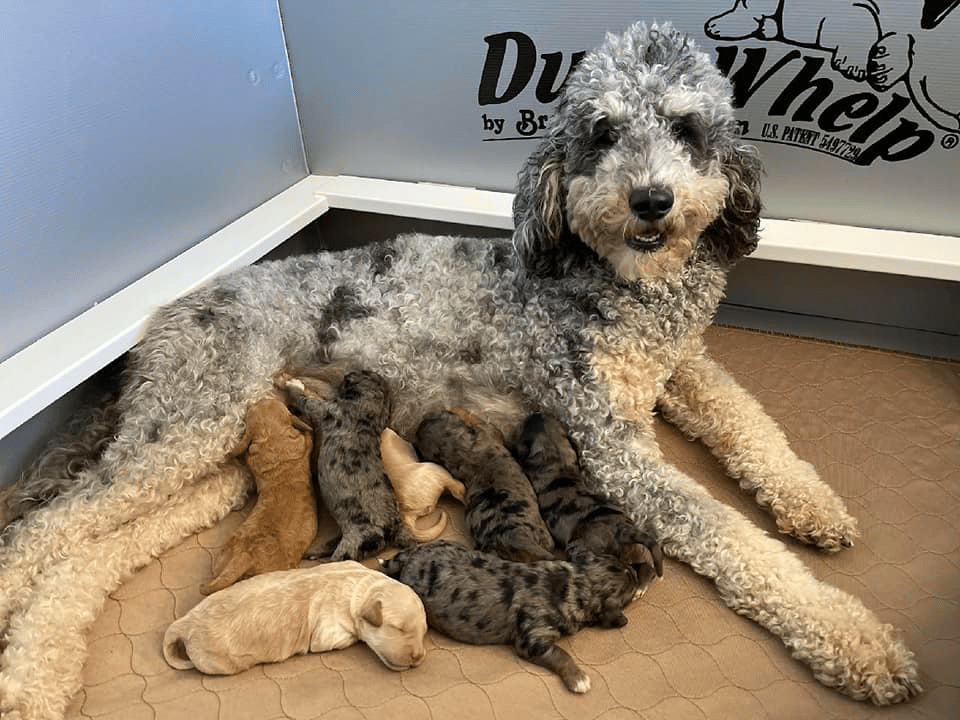
So, now that you know a lot about Goldendoodles, what’s left is to find one yourself. Whether you’re getting your Groodle from a breeder or from a rescue or shelter, the next few points should be useful.
First off, Groodle puppies are cute and adorable, I mean, it’s the reason for their increased popularity. It’s also the reason greedy breeders and puppy mills love them. Adorable puppies sell.
But you might not need to break the bank for an adorable Groodle. Your local rescue or shelter might have a Goldendoodle just for you.
But if you do plan on purchasing a Goldendoodle, Do pick a breeder that prioritizes health and has done the necessary health test which ensures that their Groodles are free from any possible genetic diseases that are common with Golden Retrievers and Poodles.
On average, a Goldendoodle ranges from $700 to $3000, so do ensure you get your money’s worth when purchasing from a breeder.
Also, try avoiding breeders that seem in a hurry to unload their Goldendoodle on you. You should also be mindful of purchasing a puppy from a website that offers to quickly ship your pup to you.
Take out time to research the puppy you want, so as to not get disappointed or heartbroken.
So how do you know which Goldendoodle breeder is reputable? they all have websites. Well, there are a couple of red flags that you should be aware of. Some of the red flags include:
- Over availability,
- Having the choice of any puppy.
- Having multiple litters.
- The option of paying online.
These might all seem convenient but they are risky.
Distinguishing a disreputable breeder from a reputable breeder might prove a challenge, there’s no foolproof way of guaranteeing that you never purchase a sick puppy. However, extensively researching the breed, and facility and generally asking the right questions can help reduce the chances of that happening.
The cost of getting a Groodle puppy depends on the breeder’s locale and also whether they have the necessary health clearances of the pup and the pup’s parents.
Also, ensure you are getting a puppy that is being raised in a clean environment and is well-socialized. Giving them a confident and healthy start to their beautiful lives.
Is A Goldendoodle Right For You?
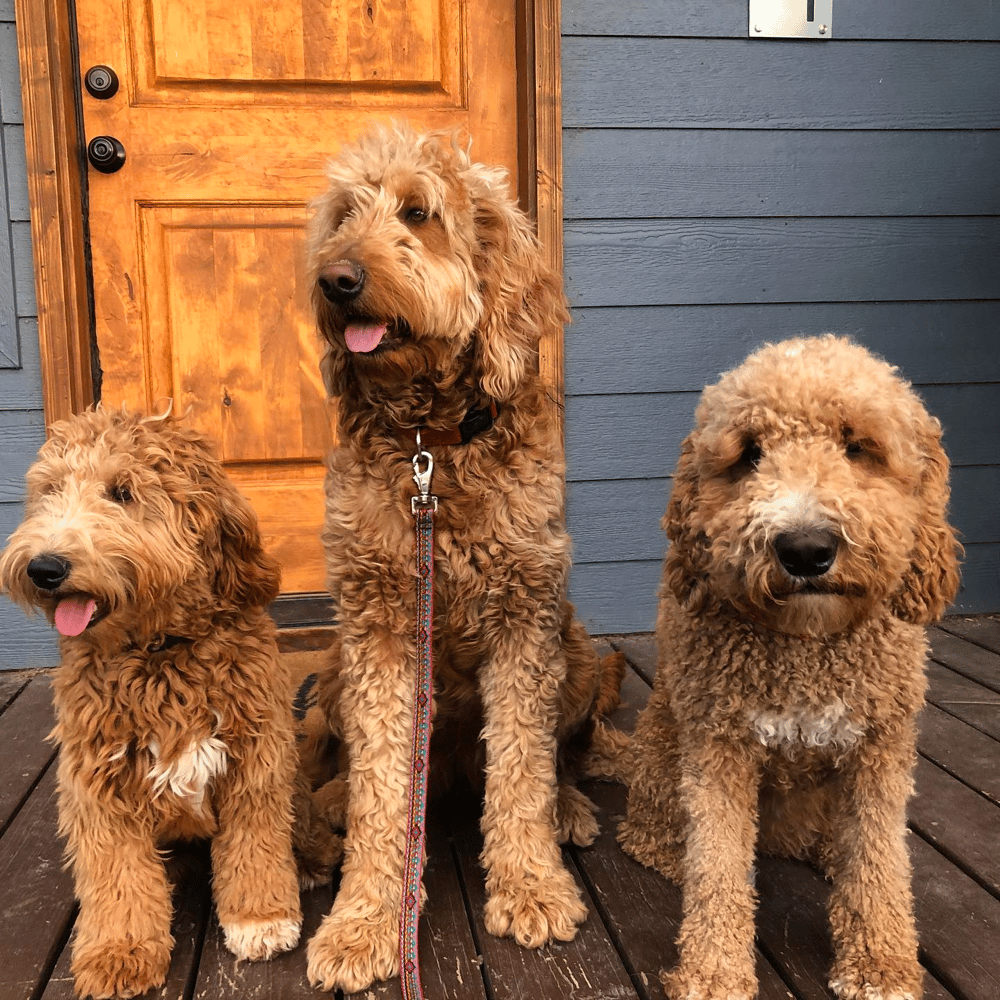
The Goldendoodle crossbreed is the perfect breed for your family. With its calm social nature, intelligence, and playful character it’s no wonder the demand for the Golden Retriever and Poodle mix is quite high.
But like always, you have to be careful when choosing the right dog for your family. Do proper research on the breeder before purchasing a Groodle. Ask for the necessary health clearances and certifications.
And remember that irrespective of the breed or mix, what really matters is that you love your dog. There you have it! All you need to know about the Goldendoodle hybrid. I hope you enjoyed reading it.
Other Golden Retriever Mixes
- Golden Retriever Vs Goldendoodle: Differences in Temperament, Trainability, Intelligence
- Goldador (Golden Retriever Lab Mix)
- Golden Boxer (Golden Retriever Boxer Mix)
- Golden Collie (Golden Retriever Border Collie Mix)
- Golden Retriever Husky Mix: Active, Energetic, and Companionable Dog
- Golden Retriever Great Pyrenees Mix: A Fluffy Giant
- Golden Retriever Corgi Mix: The Stubby-Legged Mixed Breed
- Bernese Mountain Dog Golden Retriever Mix: Gentle, Loyal, and Smart
- The Australian Shepherd Golden Retriever Mix: New on the Scene
- Goldmation (Golden Retriever Dalmatian Mix)
